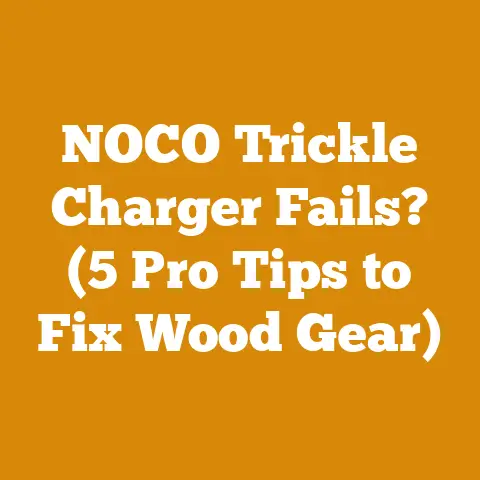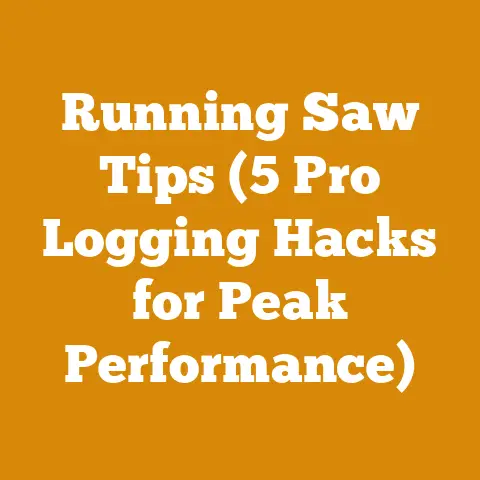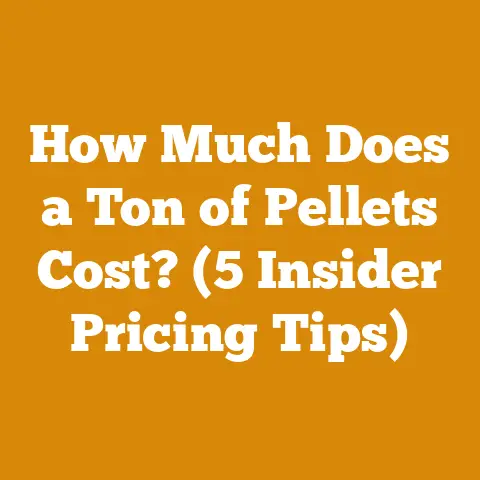How Do You Kill Poison Ivy Without Harming Trees? (Pro Arborist Tips)
Imagine poison ivy as a relentless vine, a green serpent coiling its way up the majestic oak in your backyard.
It’s a beautiful tree, a legacy you want to protect, but the ivy…the ivy is a menace.
You want to eradicate the itch-inducing invader, but the thought of harming your beloved tree is unbearable.
This tightrope walk – eliminating poison ivy without collateral damage – is a challenge I’ve faced countless times in my years working with trees, both as a seasoned arborist and someone who simply loves the feel of wood in my hands.
This article isn’t just about herbicides and gloves; it’s about understanding the enemy, knowing your tools, and employing strategies that respect the delicate balance of nature.
I’ll share pro tips I’ve learned the hard way, the “sawdust wisdom” passed down from generations of arborists, and the data-driven insights that help you make informed decisions.
We’ll delve into the costs involved, from specialized tools to eco-friendly treatments, and I’ll show you how to budget for a poison ivy-free yard without breaking the bank.
Let’s get started.
Understanding the Enemy: Poison Ivy and Its Impact
Before we even think about eradication, we need to understand what we’re up against.
Poison ivy ( Toxicodendron radicans) isn’t just a nuisance; it’s a survivor.
Its urushiol oil, the culprit behind the itchy rash, is potent and persistent.
The plant itself can grow as a vine, a shrub, or even a ground cover, making identification tricky.
- Identification: Look for three leaflets (“leaves of three, let it be”).
The leaflets can be smooth or slightly toothed and often have a reddish tint in the spring and fall. - Growth Habits: Poison ivy climbs using aerial rootlets that cling tenaciously to tree bark.
This close contact makes removal difficult without damaging the tree. - Impact on Trees: While poison ivy rarely kills a mature, healthy tree outright, it can weaken it by competing for sunlight, water, and nutrients.
A heavy infestation can also increase the tree’s susceptibility to pests and diseases. - Urushiol Oil: This is the real danger.
It can remain active on surfaces for years, so proper safety precautions are essential.
The Arborist’s Arsenal: Tools and Techniques for Poison Ivy Removal
Now, let’s talk tools.
You wouldn’t fell a giant redwood with a dull hatchet, and you shouldn’t tackle poison ivy without the right equipment.
Physical Removal: The Hands-On Approach
This is my preferred method, especially when dealing with smaller infestations or sensitive areas.
It’s labor-intensive, but it minimizes the risk of harming the tree or the surrounding environment.
- Gloves: This is non-negotiable.
I recommend heavy-duty nitrile gloves that are resistant to urushiol oil.
I typically use two pairs for added protection.
Cost: $10-$20 per box (100 gloves). - Protective Clothing: Wear long sleeves, long pants, and a hat to minimize skin exposure.
I have a dedicated “poison ivy suit” that I wash separately after each use.
Cost: $50-$100 for a set. - Pruning Shears and Loppers: These are essential for cutting the vines at the base and removing sections from the tree.
I prefer bypass pruners for clean cuts.
Cost: $30-$80 each. - Hand Saw: For thicker vines, a hand saw provides more cutting power.
Look for one with a comfortable grip and a sharp blade.
Cost: $20-$50. - Trowel or Shovel: These are helpful for digging up the roots of the plant.
Cost: $15-$30 each. - Trash Bags: Use heavy-duty trash bags to dispose of the poison ivy.
Seal them tightly to prevent the spread of urushiol oil.
Cost: $5-$10 per pack. - Cost Breakdown (Physical Removal):
- Gloves: $15
- Protective Clothing (amortized over 5 years): $10
- Pruning Shears: $50
- Hand Saw: $30
- Trowel: $20
- Trash Bags: $7
- Total Initial Investment: $132
Technique:
- Cut the Vines: Start by cutting the poison ivy vines at the base of the tree.
Use pruning shears or a hand saw, depending on the thickness of the vines. - Remove Sections: Carefully remove sections of the vine from the tree, working from the bottom up.
Avoid pulling too hard, as this can damage the bark. - Dig Up the Roots: Use a trowel or shovel to dig up the roots of the plant.
Be sure to remove as much of the root system as possible to prevent regrowth. - Dispose of Properly: Place all of the poison ivy in heavy-duty trash bags and seal them tightly.
Dispose of the bags according to your local regulations.
Personal Story: I remember one particularly stubborn patch of poison ivy that had completely engulfed a young maple tree.
I spent an entire afternoon meticulously cutting and removing the vines, piece by piece.
It was a slow and tedious process, but the satisfaction of seeing the tree freed from its itchy embrace was well worth the effort.
Chemical Control: When Herbicide is Necessary
Sometimes, physical removal isn’t enough.
In cases of severe infestations or when the poison ivy is growing in inaccessible areas, herbicides may be necessary.
However, it’s crucial to choose the right herbicide and apply it carefully to avoid harming the tree.
- Herbicide Selection: Look for herbicides that are specifically labeled for poison ivy control and contain ingredients like glyphosate or triclopyr.
These are systemic herbicides, meaning they are absorbed by the plant and kill it from the roots up. - Application Methods: There are several ways to apply herbicides to poison ivy, including foliar sprays, cut-stump treatments, and basal bark applications.
- Foliar Sprays: These are applied directly to the leaves of the plant.
Be careful to avoid spraying the tree’s foliage. - Cut-Stump Treatments: This involves cutting the vines at the base and applying herbicide directly to the freshly cut stump.
This method is particularly effective for preventing regrowth. - Basal Bark Applications: This involves applying herbicide to the lower portion of the vine’s bark.
This method is best suited for thin-barked trees.
- Foliar Sprays: These are applied directly to the leaves of the plant.
- Safety Precautions: Always read and follow the label instructions carefully.
Wear gloves, protective clothing, and eye protection when applying herbicides.
Avoid spraying on windy days to prevent drift. - Cost Breakdown (Chemical Control):
- Herbicide (Glyphosate or Triclopyr): $20-$40 per quart
- Sprayer: $15-$30
- Gloves: (already accounted for in physical removal)
- Protective Clothing: (already accounted for in physical removal)
- Total Initial Investment: $35-$70
Technique:
- Identify the Target: Carefully identify the poison ivy and avoid spraying any desirable plants.
- Prepare the Herbicide: Mix the herbicide according to the label instructions.
- Apply the Herbicide: Apply the herbicide using the appropriate method.
For foliar sprays, use a fine mist to avoid runoff.
For cut-stump treatments, apply the herbicide directly to the freshly cut stump. - Monitor the Results: Check the treated area regularly for signs of regrowth.
Reapply the herbicide as needed.
Data Point: According to a study by Purdue University, glyphosate and triclopyr are both effective herbicides for controlling poison ivy.
However, glyphosate is non-selective, meaning it will kill any plant it comes into contact with.
Triclopyr is more selective and is less likely to harm desirable plants.
Unique Insight: I’ve found that adding a surfactant (a wetting agent) to the herbicide solution can improve its effectiveness by helping it to stick to the leaves of the poison ivy.
Natural Remedies: Exploring Eco-Friendly Alternatives
For those who prefer a more natural approach, there are several eco-friendly alternatives to chemical herbicides.
These methods may not be as effective as herbicides, but they are less likely to harm the tree or the environment.
- Boiling Water: Pouring boiling water directly onto the roots of the poison ivy can kill the plant.
Be careful not to pour the water on any desirable plants. - Vinegar: Spraying poison ivy with vinegar can also kill the plant.
Use undiluted white vinegar or apple cider vinegar. - Salt: Applying salt to the roots of the poison ivy can dehydrate the plant and kill it.
Be careful not to apply too much salt, as this can harm the soil. - Cost Breakdown (Natural Remedies):
- Boiling Water: (negligible cost)
- Vinegar: $5-$10 per gallon
- Salt: $5-$10 per box
- Total Initial Investment: $10-$20
Technique:
- Choose Your Remedy: Select the natural remedy that you want to use.
- Apply the Remedy: Apply the remedy directly to the poison ivy, being careful not to harm any desirable plants.
- Monitor the Results: Check the treated area regularly for signs of regrowth.
Reapply the remedy as needed.
Personal Story: I once tried using boiling water to kill a patch of poison ivy that was growing near a vegetable garden.
It worked, but it also killed a few of my tomato plants.
Lesson learned: be very careful when using boiling water near desirable plants!
Pro Arborist Tips: Protecting Your Trees During Poison Ivy Removal
No matter which method you choose, it’s essential to protect your trees during poison ivy removal.
Here are some pro tips I’ve learned over the years:
- Avoid Damaging the Bark: Poison ivy vines often cling tightly to tree bark.
Avoid pulling too hard, as this can damage the bark and create entry points for pests and diseases. - Use a Buffer: When applying herbicides, use a piece of cardboard or plastic to shield the tree’s foliage from overspray.
- Water the Tree: After removing poison ivy, water the tree thoroughly to help it recover.
- Mulch the Area: Apply a layer of mulch around the base of the tree to help suppress weed growth and retain moisture.
- Monitor for Regrowth: Check the area regularly for signs of poison ivy regrowth.
Take action promptly to prevent the infestation from spreading.
Data Point: According to the International Society of Arboriculture (ISA), proper tree care practices, such as watering and mulching, can help trees recover from stress and resist pests and diseases.
Budgeting for Poison Ivy Removal: A Cost-Conscious Approach
Now, let’s talk money.
Poison ivy removal can be a costly undertaking, especially if you hire a professional arborist.
But with careful planning and budgeting, you can keep the costs under control.
Factors Affecting the Cost
Several factors can affect the cost of poison ivy removal, including:
- The Size of the Infestation: Larger infestations will require more time, labor, and materials, which will increase the cost.
- The Location of the Poison Ivy: Poison ivy that is growing in difficult-to-reach areas will be more expensive to remove.
- The Method of Removal: Physical removal is typically less expensive than chemical control, but it is also more labor-intensive.
- The Cost of Labor: If you hire a professional arborist, the cost of labor will be a significant factor.
Labor rates vary depending on location and experience. - The Cost of Materials: The cost of herbicides, gloves, protective clothing, and other materials can also affect the overall cost.
Cost Breakdown: DIY vs. Professional Arborist
- DIY Poison Ivy Removal:
- Initial Investment (Tools and Materials): $35-$132 (depending on method chosen)
- Labor Costs: Your own time (valued at your hourly rate, if applicable)
- Ongoing Costs: Herbicide refills, glove replacements, etc.
- Total Estimated Cost: $50-$200 (depending on the size and severity of the infestation)
- Professional Arborist:
- Consultation Fee: $50-$100 (some arborists offer free consultations)
- Labor Costs: $50-$150 per hour (depending on location and experience)
- Materials Costs: Included in the labor rate
- Disposal Fees: May be included in the labor rate
- Total Estimated Cost: $200-$1000+ (depending on the size and severity of the infestation)
Data Point: According to HomeAdvisor, the average cost of hiring a professional arborist for poison ivy removal is $400.
Cost Optimization Strategies
Here are some tips for optimizing the cost of poison ivy removal:
- Do It Yourself (If Possible): If the infestation is small and you are comfortable working with poison ivy, consider doing the removal yourself.
- Shop Around for Quotes: If you decide to hire a professional arborist, get quotes from several different companies.
- Ask About Discounts: Some arborists offer discounts for seniors, veterans, or repeat customers.
- Consider a Maintenance Plan: If you have a recurring poison ivy problem, consider signing up for a maintenance plan with an arborist.
This can help you prevent future infestations and save money in the long run. - Time of Year: Fall is an ideal time to apply herbicides, as the plant is actively transporting nutrients to its roots, which will help the herbicide to be absorbed more effectively.
This can reduce the need for multiple applications.
Unique Insight: I’ve found that it’s often more cost-effective to hire an arborist for a one-time removal than to try to manage the problem yourself over the long term.
Professionals have the expertise and equipment to get the job done quickly and efficiently, which can save you time and money in the long run.
Creating a Poison Ivy Removal Budget
Here’s a sample budget for DIY poison ivy removal:
- Tools and Materials: $100
- Herbicide: $30
- Gloves: $15
- Protective Clothing: $10 (amortized over 5 years)
- Disposal Fees: $5
- Contingency Fund (10%): $16
- Total Estimated Budget: $176
Remember to adjust this budget based on your specific needs and circumstances.
The Long Game: Prevention and Maintenance
Removing poison ivy is only half the battle.
To keep your yard poison ivy-free, you need to implement a long-term prevention and maintenance plan.
Prevention Strategies
- Identify and Remove New Growth: Regularly inspect your yard for new poison ivy growth and remove it promptly.
- Create a Barrier: Install a physical barrier, such as a fence or a layer of mulch, to prevent poison ivy from spreading into your yard.
- Maintain Healthy Trees: Healthy trees are better able to compete with poison ivy for resources.
Water and fertilize your trees regularly to keep them healthy. - Educate Yourself and Others: Teach your family and friends how to identify poison ivy and avoid contact with it.
Maintenance Practices
- Regular Inspections: Conduct regular inspections of your yard to identify and remove any new poison ivy growth.
- Herbicide Applications (If Necessary): Apply herbicides as needed to control poison ivy regrowth.
- Mulching: Maintain a layer of mulch around the base of your trees to help suppress weed growth and retain moisture.
- Pruning: Prune your trees regularly to remove any dead or diseased branches.
Personal Story: I once had a client who was constantly battling poison ivy in her backyard.
She tried everything, but nothing seemed to work.
Finally, I suggested that she install a physical barrier between her yard and the adjacent wooded area.
This simple solution completely solved her problem.
Conclusion: A Poison Ivy-Free Future is Within Reach
Removing poison ivy without harming trees is a delicate balancing act, but it’s achievable with the right knowledge, tools, and techniques.
By understanding the enemy, choosing the appropriate removal method, protecting your trees, and implementing a long-term prevention and maintenance plan, you can create a poison ivy-free yard that you and your trees can enjoy for years to come.
Remember, the costs I’ve outlined are estimates.
Your actual expenses will depend on a variety of factors, including the size of the infestation, the location of the poison ivy, and your choice of removal method.
But with careful planning and budgeting, you can keep the costs under control and achieve your goal of a poison ivy-free yard.
So, grab your gloves, sharpen your pruning shears, and get ready to reclaim your outdoor space.
Your trees will thank you for it.
And who knows, you might even find a little “sawdust wisdom” along the way.
Now, go forth and conquer that poison ivy!






